The 5 Pillars Of Digital Transformation | Everything Explained
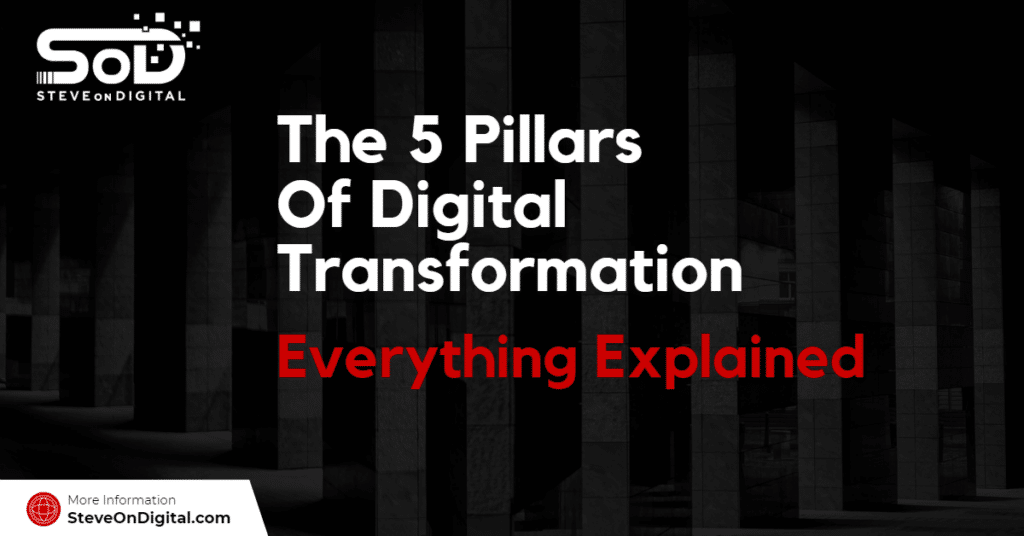
The 5 pillars of digital transformation are digital mindset, digital strategy, customer experience, data-driven decision-making, and digital technologies. These core, five key elements will guide businesses through the process of integrating digital technologies into their operations, driving significant improvements and long-term success. Digital transformation involves more than just updating technology; it requires a shift in mindset and strategy. By focusing on these five pillars, businesses can navigate their digital transformation journey effectively, enhancing their organization’s ability to innovate, improve customer satisfaction, and stay competitive in an increasingly digital world. I’m Steve, a digital transformation expert with a strong background in electrical engineering, an MBA, and a master’s in Project Management. I excel at helping SMEs navigate the digital landscape with practical insights. Let’s begin! Understanding the 5 Pillars of Digital Transformation The journey to a successful digital transformation rests on five key pillars: digital mindset, digital strategy new business models, customer experience, data-driven decision making, and digital technologies. These pillars provide a comprehensive framework to guide businesses through their digital transformation efforts. Pillar Description Digital Mindset Adopting a forward-thinking approach and being open to change. Digital Strategy Aligning digital initiatives with overall business goals. Customer Experience Enhancing interactions through personalized, seamless experiences. Data-Driven Decision Making Leveraging data to inform strategic business decisions. Digital Technologies Utilizing emerging technologies to transform business processes. Digital Mindset Cultivating and creating a digital mindset is essential for any organization looking to thrive in today’s digital age. It involves adopting a forward-thinking approach and being open to change. Embracing Change To foster a culture open to technological advancements and innovation, businesses must encourage flexibility and adaptability. This can be achieved by promoting a growth mindset among employees and celebrating innovation. For example, when I implemented a new project management tool in my company, it streamlined our processes and improved efficiency. The key was to involve everyone in the transition and highlight the benefits of the new technology. Continuous Learning Staying updated with new technologies requires continuous learning. Encouraging ongoing education and skill development helps keep pace with technological advancements. I often attend workshops and online courses to stay ahead and bring fresh insights to my business. Providing employees with access to training resources ensures that everyone is equipped to handle new digital tools and processes. Benefit Impact Increased Innovation Fosters a culture of creativity and problem-solving. Improved Efficiency Streamlines processes and reduces operational costs. Enhanced Employee Morale Encourages continuous learning and professional development. Digital Strategy A well-crafted digital strategy aligns digital products with your overall business goals, ensuring that digital transformation efforts are targeted and effective. Aligning with Business Objectives Your digital strategy should support and enhance your business strategy. This involves identifying how digital tools can help achieve your business goals. For instance, when I aligned my digital marketing efforts with my business objectives, I saw a significant increase in customer engagement and sales. Defining Clear Goals and Metrics Setting measurable objectives is crucial for tracking progress and success. Establish key performance indicators (KPIs) that align with your digital strategy. Regularly review these metrics to ensure your digital initiatives are on track. When I set clear goals for my website traffic and conversion rates, it became easier to measure the effectiveness of my digital marketing campaigns. Metric Description Example Customer Engagement Measures interaction with digital channels. Social media likes, shares, and comments. Conversion Rate Percentage of visitors who complete a desired action. Purchases, sign-ups, or downloads on the website. Return on Investment (ROI) Financial gain compared to the investment cost. Revenue generated from a marketing campaign. Customer Experience Enhancing customer interactions through digital means is a cornerstone of digital transformation. A seamless, personalized experience can significantly improve customer satisfaction and loyalty. Personalized Services Using data to create tailored customer experiences is a powerful way to enhance engagement. For example, analyzing customer behavior on my website allowed me to offer personalized product recommendations, which increased sales and customer satisfaction. Omni-Channel Engagement Providing seamless interactions across various digital platforms ensures that customers have a consistent experience regardless of how they interact with your business. Implementing an omni-channel strategy helped me connect with customers on social media, email, and my website, providing a unified and satisfying experience. Data-Driven Decision Making Leveraging data assets to inform strategic decisions is critical for modern businesses. Data-driven decision-making involves collecting and analyzing data to guide business strategies and improvements. Data Collection and Analysis Gathering and analyzing data effectively can reveal valuable insights about your business and customers. Utilizing tools like Google Analytics and CRM systems can help you collect and interpret data to make informed decisions. By regularly analyzing website traffic and customer feedback, I identified key areas for improvement in my business operations. Tool Purpose Features Google Analytics Website data analysis Tracks website traffic, user behavior, and conversions. Tableau Data visualization and business intelligence Creates interactive and shareable dashboards. CRM Systems (e.g., Salesforce) Customer data management Manages customer interactions and automates sales processes. Implementing Insights Using data insights to drive business improvements ensures that your strategies are based on solid evidence. For example, data analysis showed that my customers preferred mobile browsing, leading me to optimize my website for mobile devices, resulting in increased user engagement and sales. Digital Technologies Utilizing new technology to transform business processes is a fundamental aspect of digital transformation. Staying abreast of technological advancements and integrating them into your own business model can provide a competitive edge. Emerging Technologies Keeping an eye on cutting-edge technologies can help you identify new opportunities for innovation and new ideas. Technologies like artificial intelligence, machine learning, and blockchain are reshaping industries and offering new possibilities for business growth. When I incorporated AI-driven tools into my marketing strategy, it enhanced my ability to target and engage customers more effectively. Technology Description Business Application Artificial Intelligence (AI) Machines simulating human intelligence. Chatbots, predictive analytics, personalized marketing. Machine Learning (ML) Algorithms improving through experience. Fraud detection, customer segmentation, demand forecasting. Blockchain Decentralized digital ledger technology. Secure transactions, smart contracts, supply chain transparency.
Top Challenges Of Digital Transformation And How To Overcome Them
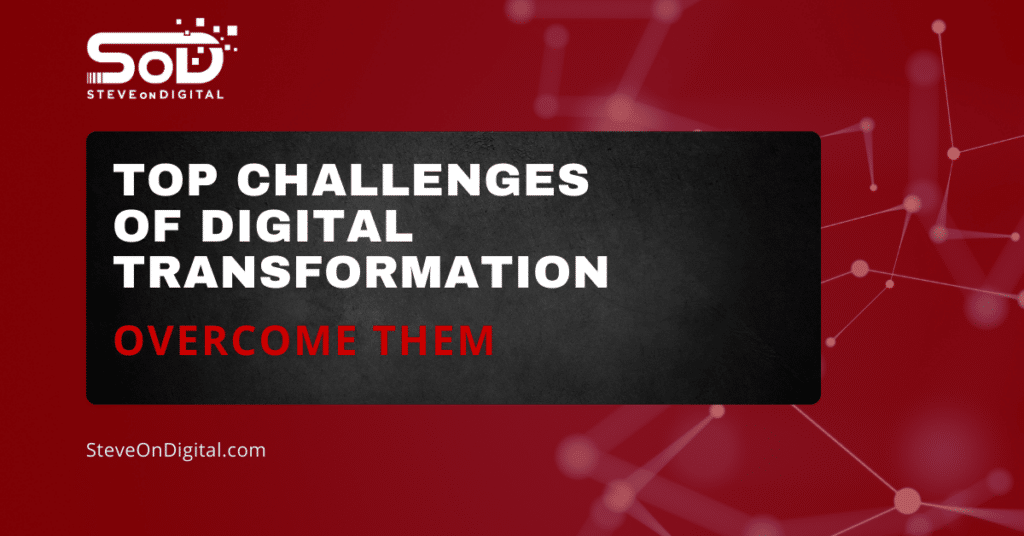
Digital transformation means using new digital tools to change how a business works, its culture, and how it interacts with customers. This transformation can face many challenges, including legacy systems, change management issues, and a digital skills gap. These obstacles can slow down progress and make it difficult to fully leverage the digital processes and technologies. In today’s competitive environment, with digital transformation difficult, understanding these challenges is crucial for success. Addressing these issues can help businesses streamline operations, enhance customer experiences, and stay ahead in the market. Through careful planning and strategy, companies can overcome these hurdles and achieve a successful digital transformation. I’m Steve, a digital transformation expert with a strong background in electrical engineering, an MBA, and a master’s in Project Management. I excel at helping SMEs navigate the new digital solutions landscape with practical insights. Let’s begin! Understanding Digital Transformation What Is Digital Transformation? Digital transformation means using digital tools to change how businesses work, improve company culture, and enhance customer experiences to stay up-to-date with market needs. It involves rethinking business in the digital world. The Digital Transformation Journey Every business’s digital transformation journey is unique, but it typically includes the following stages: Stage Description Awareness and Vision Recognizing the need for digital transformation and setting clear goals. Evaluation and Planning Assessing current capabilities and planning the transformation strategy. Execution and Implementation Deploying new technologies and processes. Optimization Continuously improving and adapting to new digital advancements. Digital Transformation Process The digital transformation process involves several key steps: Key Challenges of Digital Transformation Challenge Description Strategy Legacy Systems Outdated technologies incompatible with new technologies, leading to high maintenance costs. Consider phased upgrades or migrations to modern platforms. Change Management Strategy Overcoming resistance and ensuring a smooth transition through communication, training, and support. Engage stakeholders early, provide clear communication, and offer training programs. Digital Skills Gap Shortage of professionals with necessary digital skills, slowing down transformation efforts. Invest in training and development programs, collaborate with educational institutions, and consider outsourcing or partnerships. Legacy Systems Outdated technologies and systems, often referred to as legacy systems, can significantly hinder digital transformation efforts. These systems are typically incompatible with new technologies, leading to integration issues and high maintenance costs. Upgrading or replacing these systems is often necessary but can be complex and costly (Exploding Topics) (Digital Adoption). Change Management Strategy Effective and thorough change management strategy is critical to overcoming resistance and ensuring a smooth transition. This involves: Digital Skills Gap There is a significant shortage of professionals with the necessary digital skills. This skills gap can slow down transformation efforts and affect the implementation of new technologies. Investing in training and development is crucial to bridging this digital skill gap, and ensuring a successful transformation (Exploding Topics) (Digital Adoption). Data and Statistics Metric Statistic Global Spending Projection Expected to reach $3.4 trillion by 2026 Pandemic Acceleration Accelerated initiatives by an average of six years AI and Cloud Adoption 45% scaling up cloud capabilities, 39% investing in AI Leadership Involvement 72% of data and analytics leaders involved in transformation efforts Overcoming Digital Transformation Challenges Developing Digital Skills Bridging the digital skills gap is crucial for any organization’s digital transformation journey. Many organizations face this challenge due to the rapid pace of technological advancements. To address this, I recommend the following strategies for looming digital skill gap: Strategy Description Invest in Training Programs Ongoing training and upskilling opportunities for employees. Leverage Online Learning Platforms Using platforms like Coursera, Udemy, and LinkedIn Learning for digital skills courses. Partner with Educational Institutions Collaborating with universities and technical schools for tailored programs. A study found that 87% of organizations recognize that upskilling their employees is necessary to stay competitive (Exploding Topics). Implementing Change Management Effective change management is essential to reduce resistance and ensure a smooth and seamless transition to transition during digital transformation. Practice Description Clear Communication Clearly communicate the vision and benefits of digital transformation to all employees. Employee Involvement Involve employees in the planning and implementation process to increase buy-in and reduce resistance. Provide Support and Resources Offer training, resources, and support to help employees adapt to new technologies and processes. Here are some best practices: Statistics show that 70% of change programs fail due to employee resistance and lack of management support (Whatfix). Upgrading Legacy Systems Modernizing or replacing outdated systems is a significant challenge in digital transformation. Here are some approaches: According to recent data, 56% of organizations cite upgrading obsolete IT infrastructure as a top reason for increased IT budgets (Exploding Topics). Digital Transformation Initiatives Planning Digital Initiatives Effective planning is key to the success of digital transformation initiatives. Here are the steps: Data shows that 64% of organizations believe they need to build new digital businesses to stay competitive (Exploding Topics). Implementing Digital Solutions Deploying new digital tools and technologies effectively requires a structured approach: Statistics indicate that 45% of small and medium businesses encounter budget limitations as a major challenge in executing digital strategies (DOIT). Monitoring Digital Transformation Programs Tracking and measuring the success of digital transformation initiatives is crucial. Here’s how to do it effectively: Studies show that organizations with effective monitoring strategies prioritize digital investments are more likely to achieve successful digital transformation (Whatfix). Technological Challenges Integration of New Technologies Integrating new technologies with existing systems can be challenging. Here are some tips: Research indicates that 84% of organizations are exploring or using AI and machine learning for digital-first business (DOIT). Technology Procurement Plans and Budgets Managing technology procurement and budgets effectively is essential. Consider the following: Data shows that 51% of digital transformation efforts arise from growth opportunities and increased competitive pressure (Whatfix). Maintaining Secure Digital Transformation Security is a critical concern during digital transformation. Here’s how to implement effective security measures: According to recent statistics, 95% of organizations believe that digital transformation leads to higher efficiency in tackling challenges (Exploding Topics). Cultural and Organizational Challenges Risk-Averse Organizational Culture A conservative corporate culture can significantly hinder digital transformation. Many businesses are wary
Digital Transformation Framework | A Guide For Businesses

A digital transformation framework is a plan for using digital technologies in all parts of a business. This process fundamentally changes how a business operates and delivers value to customers. Digital transformation is essential in today’s fast-paced market. It helps businesses stay competitive and meet evolving customer expectations. The global market for digital transformation is projected to reach $3.4 trillion by 2026, highlighting its critical role in modern business strategies. Adapting to these changes is crucial for improving efficiency, enhancing customer satisfaction, and driving growth. I’m Steve, a digital transformation expert with a strong background in electrical engineering, an MBA, and a master’s in Project Management. I excel at helping SMEs navigate the next digital technology landscape with practical insights. Let’s begin! Understanding Digital Transformation Digital transformation means using digital technology in every part of a business. It changes how the business works and how it serves customers, creating new ways of doing things. Definition Of Digital Transformation Digital transformation encompasses the adoption of digital technologies to improve processes, enhance customer experiences, and drive business growth. It includes technologies like cloud computing, data analytics, artificial intelligence, and more. Importance Of Digital Transformation The significance of digital transformation cannot be overstated. It offers numerous benefits, such as improved efficiency, enhanced customer satisfaction, and increased agility. For instance, businesses that embrace digital transformation are better positioned to respond quickly to market changes and customer demands. Key Elements Of Digital Transformation Element Description Technology Integrating new digital tools and platforms to enhance operations and services. Strategy Developing a clear roadmap for digital initiatives aligned with business goals. Culture Fostering a culture that embraces change and innovation, encouraging continuous improvement. Components Of A Digital Transformation Framework A strong digital transformation framework that provides a structured approach to implementing digital changes. Technology Integration Successfully integrating new technologies into existing systems is crucial. This involves careful planning and execution to avoid disruptions and maximize benefits. Strategic Planning Having a solid strategy is vital for digital transformation. It should outline clear goals, objectives, and a timeline to guide the digital transformation process through. Organizational Culture A supportive organizational culture is essential. Encouraging a mindset open to change and innovation helps ensure the success of all digital transformation strategies and initiatives. Change Management Effective change management techniques are necessary to address resistance and ensure smooth transitions. This includes communication, training, and support to help business and it leaders and employees adapt to new technologies and processes. Building a Digital Transformation Strategy Creating a robust and effective digital transformation framework and strategy is a multi-step process that involves careful planning, resource allocation, and continuous evaluation. Here’s how I approach it, based on my experience and extensive research: Step Description Assessing Current State Evaluating existing systems, processes, and technologies to understand their current capabilities and limitations. Setting Goals And Objectives Aligning digital transformation goals with the overall business strategy to ensure alignment with broader objectives. Developing A Roadmap Creating a detailed plan with manageable tasks and realistic timelines to guide digital transformation efforts. Allocating Resources Investing in the right technology, budget, and skilled personnel to support and sustain digital transformation initiatives. Assessing Current State Before diving into digital transformation, it’s crucial to understand where your business stands. This means evaluating existing systems, processes, and technologies. Conduct interviews, surveys, and analyze documentation to identify pain points and areas for improvement. This assessment helps pinpoint what needs to change and sets a clear baseline for progress. Setting Goals And Objectives Setting clear, achievable goals is essential. Make sure your goals match your business plan so that digital changes help you reach your bigger goals. For instance, if your goal is to improve customer experience, you might aim to reduce response times using digital tools. Clear objectives help keep the digital transformation project focused and measurable. Developing A Roadmap A well-defined roadmap is your action plan. Break down your goals into manageable tasks with realistic timelines. Assign responsibilities and ensure everyone knows their role. This roadmap should be flexible enough to adapt to new challenges and opportunities but detailed enough to guide day-to-day activities. Allocating Resources Successful digital transformation requires the right resources. This includes budget, technology, and skilled personnel. Invest in training to upskill your team and ensure they’re equipped to handle new digital tools and processes. Allocate your budget wisely, focusing on technologies that offer the most significant impact and quick wins. Implementing The Digital Transformation Framework Implementation is where strategy meets action. Here are the best practices I follow: Pilot Programs Start with pilot programs to test and refine your approach. These small-scale projects help identify potential issues and opportunities without the risk of a full-scale rollout. Pilots also provide tangible results that can help gain buy-in from stakeholders. Scaling Up Once pilot programs prove successful, scale them up across the organization. This requires careful planning to ensure that the expanded implementation remains consistent and effective. Use lessons learned from pilot programs to improve the broader rollout. Continuous Improvement Digital transformation is an ongoing process. Regularly assess and refine your efforts to stay aligned with evolving business needs and technological advancements. Use data and feedback to drive continuous improvement and keep the digital transformation frameworks dynamic and relevant. Tools And Technologies In Digital Transformation Leveraging the right tools business models and technologies is vital for driving transformation: Technology Benefits Cloud Computing Scalability, flexibility, cost-efficiency. Supports efficient data storage and processing. Data Analytics Informed decision-making, understanding customer behavior, process optimization. Artificial Intelligence (AI) Automating tasks, enhancing decision-making, personalizing customer experiences. Mobile Technologies Enhancing accessibility and engagement, providing seamless customer experiences across devices. Cloud Computing Cloud computing offers scalability, flexibility, and cost-efficiency. It enables businesses to store and process data efficiently, supporting everything from everyday operations to innovative new services. According to Gartner, by 2026, global cloud spending is expected to reach $832 billion (Digital Adoption). Data Analytics Data analytics is crucial for informed decision-making. It helps businesses understand customer behavior, optimize processes, and uncover new opportunities. Implementing advanced analytics can
How To Create A More Sustainable Business Strategy | Comprehensive Guide

As a Digital Transformation Specialist and the voice behind SteveOnDigital, I’ve dedicated my career to steering small and medium-sized enterprises (SMEs) towards digital and sustainable success. With my expertise rooted in electrical engineering and expanded through an MBA and a master’s in Project Management, I understand deeply how crucial a sustainable business strategy is not just for compliance, but for thriving in today’s fast-paced market. My approach is hands-on, drawing from a rich blend of industry knowledge and personal commitment to family, sports, and continuous education. Today, I’m sharing insights on how to craft a more sustainable business strategy that ensures long-term success while positively impacting our community and planet. This isn’t just business—it’s about building a legacy that respects both the earth and its inhabitants. Introduction To Sustainable Business Strategies When I first ventured into the digital landscape with SteveOnDigital, I realized that the core of enduring success was sustainability—not just in terms of content but in every aspect of business. Today, I’m diving deep into why creating a more sustainable business strategy is not just a good-to-have, but a must-have in today’s business environment. Sustainability in business goes beyond green practices; it’s about designing operations that can thrive over the long term without depleting the resources or harming the society on which they depend. It’s about building a business that not only grows but improves the fabric of the community and protects the environment. Integrating sustainable practices is not just beneficial for the environment but is also a key driver of business success, ensuring that sustainability is connected to business success in any sustainability strategy development. As a business owner, my goal is to integrate sustainable practices that align closely with both business needs and environmental stewardship. Understanding The Foundations Of Sustainability Understanding the strategic aspect of a business sustainability strategy can transform the way you operate and how you are perceived in the market, emphasizing the importance of executive leadership in driving purpose-driven and authentic leadership from across the organization. Definition And Principles Of Sustainability A sustainable business strategy is one that fosters business growth while positively managing the company’s impact on the environment and society. For me, this strategy isn’t just a concept but a practice. It involves systematically applying changes that conserve resources, reduce negative environmental impacts, and balance social concerns with business needs. At its core, a sustainable business strategy includes: Comparing Sustainable And Traditional Strategies Traditional business models often prioritize short-term gains and profitability with little consideration for long-term sustainability. In contrast, a sustainable business strategy focuses on long-term outcomes and benefits. It’s a shift from a profit-only mindset to a profit-with-purpose philosophy. From my experience, transitioning to a more sustainable business approach has not only enhanced SteveOnDigital’s brand reputation but has also opened up new investment opportunities. Clients and consumers today are more conscious about whom they do business with or purchase from, making sustainability a critical factor in their decision-making process. This emphasis on sustainable practices aligns closely with my own experiences and the real-time data I’ve seen: companies integrating sustainability are witnessing growth in their brand reputation and customer loyalty. They’re not just surviving; they’re thriving by respecting and enhancing the community and environment around them. Feature Traditional Business Strategy Sustainable Business Strategy Focus Short-term financial gain Long-term value creation Resource Usage High consumption, less efficiency Resource-efficient, low waste Stakeholder Engagement Limited to investors and shareholders Includes broader community and environment Risk Management Reactive Proactive and preventive Regulatory Compliance Meets minimum requirements Exceeds standards to ensure future viability Innovation Incremental improvements Innovation driven by sustainability challenges Strategic Planning For Sustainability As I delve deeper into making SteveOnDigital not just a business but a sustainable enterprise, strategic planning is a cornerstone I cannot ignore. Integrating sustainability into strategic planning isn’t just about being responsible; it’s a smart business move that can drive long-term success. Strategic planning for sustainability begins with a thorough assessment. It’s crucial to understand where you currently stand before setting a course for where you want to go. This involves looking at everything from your resource usage and supply chain operations to how your business practices affect the community and environment. It’s not just about finding problems but also recognizing opportunities where sustainability can be woven into existing and new business strategies. A successful sustainability strategy involves integrating sustainability into the core strategic planning of the business, ensuring a clear vision, gaining buy-in from top management, efficient communication at all levels within the organization, and establishing a fundamental connection between the sustainability strategy and the overall business strategy. Sustainability Assessment Conducting a sustainability assessment was an eye-opener for me. It showed me areas where my business was already making a positive impact and areas where we could improve significantly. To start, I evaluated our energy consumption, waste management, and the sustainability of the materials we use. Here’s how you can do it: By understanding the baseline, you can make informed decisions that lead to significant improvements. The role of sustainability professionals is crucial in conducting thorough sustainability assessments and developing effective strategies to integrate sustainability into business operations. Setting Clear Sustainability Goals After the assessment, it’s crucial to set clear, achievable sustainability goals. These goals should be specific, measurable, achievable, relevant, and time-bound (SMART). For instance, reducing greenhouse gas emissions by 25% within five years or achieving zero waste to landfill by 2030. These aren’t just numbers; they reflect a commitment to a sustainable future. Here’s how I approached setting these goals: Engaging Stakeholders In Sustainability Initiatives Business leaders play a pivotal role in engaging stakeholders and championing sustainability initiatives within their organizations, ensuring that these efforts are deeply integrated into the business strategy. One of the most crucial lessons I learned in enhancing sustainability at SteveOnDigital is the importance of engaging both internal and external stakeholders. Their buy-in is essential because sustainability is a team sport—it’s about collective action towards a common goal. Identifying Key Stakeholders Identifying who needs to be involved is the first step.
Impact Of Technology On Small Businesses | The Ultimate Guide
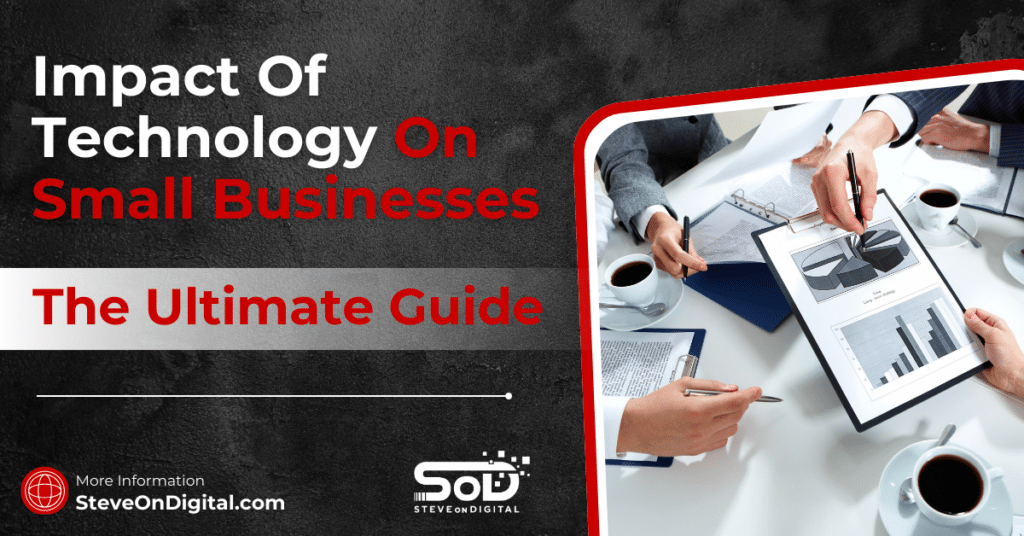
The impact of the technology platform on small businesses is profound. Technology platforms play a crucial role in empowering small business by enhancing operations, improving customer service, and driving growth. As a small business owner, I understand the need to stay ahead of technological trends. This article explores how technology affects small businesses and provides insights to help owners navigate the digital landscape effectively. The Chamber Technology Engagement Center (C_TEC), in collaboration with Teneo Research, conducted a nationwide survey to demonstrate the benefits of technology for small businesses. I’m Steve, a digital transformation expert with a strong background in computer science education electrical engineering, an MBA, and a master’s in Project Management. I excel at helping SMEs navigate the digital landscape with practical insights. Let’s begin! Evolution Of Technology In Small Businesses Historical Context The adoption of technology in small businesses in modern world has been driven by technological advancements and has been a gradual but significant process. From the early days of using basic accounting software to today’s advanced artificial intelligence systems, the evolution is remarkable. Key milestones include the introduction of personal computers in the 1980s, the internet boom in the 1990s, and the mobile revolution in the 2000s. These advancements have transformed how small businesses operate, making processes more efficient and accessible. Era Key Technological Milestone Impact on Small Businesses 1980s Introduction of Personal Computers Improved productivity and data management 1990s Internet Boom Enhanced communication and access to global markets 2000s Mobile Revolution Increased mobility and remote work capabilities 2010s Cloud Computing Scalable data storage and cost-effective solutions 2020s Artificial Intelligence and IoT Automation, advanced analytics, and improved decision-making Current Landscape Currently, small businesses are leveraging a diverse range of technologies to stay competitive. Digital transformation strategies are being adopted to enhance operational efficiency and customer engagement. The small business ecosystem has been significantly impacted by technology platforms, driving economic success and enabling businesses to thrive with digital tools. Technology platforms play a critical role in helping small businesses navigate challenges such as workforce shortages and inflation. High-speed broadband access and instant messaging have revolutionized communication, while online stores have expanded market reach. Commonly used technologies include digital tools for project management, cloud storage for data management, and AI for customer service. The integration of these technologies has created a dynamic and innovative small business landscape. Benefits Of Technology For Small Businesses Benefit Description Examples Increased Efficiency Streamlines operations, reduces manual tasks, and minimizes errors. Trello, Asana, QuickBooks Enhanced Communication Improves real-time communication and collaboration among team members. Slack, Microsoft Teams, Zoom Competitive Advantage Helps businesses stay ahead of competitors and reach a broader customer base. Shopify, AI-powered customer service tools Increased Efficiency One of the most significant benefits of technology for small businesses is increased operational efficiency. Digital tools includes small business owners streamline operations, reducing the need for manual tasks and minimizing errors. For example, project management software like Trello and Asana helps in organizing tasks, while accounting software like QuickBooks simplifies financial management. These tools save time and allow business owners to focus on strategic growth. Enhanced Communication Technology has greatly enhanced communication within small businesses. Collaboration tools have become essential for seamless teamwork and efficient project management. High-speed broadband and instant messaging platforms like Slack facilitate real-time communication among team members, regardless of their location. Email remains a vital tool for external communication, while collaboration platforms like Microsoft Teams and Zoom enable virtual meetings. These technologies improve collaboration, leading to better decision-making and productivity. Competitive Advantage Embracing technology provides a competitive advantage and enhances market competitiveness for non ai users and small businesses. Technology platforms are empowering small businesses to navigate challenges and outperform their peers. Those that adopt the latest innovations often outperform their competitors. For instance, small businesses that have integrated e-commerce platforms like Shopify have seen significant profit growth by reaching a broader customer base. Case studies show that small businesses utilizing AI for customer service have improved performance and customer satisfaction. Types Of Technology Platforms Technology Platform Description Examples Digital Tools Tools for project management, CRM, and social media management. Salesforce, Hootsuite Online Stores E-commerce platforms for reaching global customers. Shopify, WooCommerce Artificial Intelligence AI technologies for automating tasks and improving decision-making. ChatGPT, AI-driven analytics tools Digital Tools Various digital tools are available to support small businesses. Cloud computing has revolutionized data management and storage, providing scalable and cost-effective solutions. These tools range from customer relationship management (CRM) software to social media management platforms. Digital tool developers continuously release innovation to help small businesses streamline their operations and enhance productivity. For example, CRM software like Salesforce helps manage customer interactions, while social media tools like Hootsuite aid in managing online presence. Online Stores E-commerce solutions have had a major impact on small business growth. Platforms like Shopify and WooCommerce allow small businesses to set up online stores easily, reaching customers beyond geographical boundaries. The benefits include increased sales and improved customer engagement. However, setting up and managing an online store also comes with challenges such as handling logistics and customer service. Artificial Intelligence Artificial- adopted artificial intelligence is being adopted by many small businesses to automate tasks and improve decision-making. Machine learning, a subset of AI, plays a crucial role in this transformation. AI technologies can analyze large amounts of data to provide insights, automate customer service through chatbots, and personalize marketing efforts. For example, AI-powered tools like ChatGPT can assist in answering customer queries efficiently, enhancing customer experience and saving valuable time for business owners. Implementation Challenges Challenge Description Solution Learning Curve Difficulty in adopting new technologies due to unfamiliarity. Implement training programs, leverage online tutorials, collaborate with vendors. Cost Considerations High financial investment required for technology adoption. Opt for subscription services, utilize free tools, prioritize ROI. Regulatory Issues Navigating legal complexities and compliance requirements. Stay informed on regulations, seek legal advice when necessary. Learning Curve Technology adoption can be challenging due to the learning curve involved, especially as small businesses implement new technologies into their processes.
Digital Marketing Strategies For Small Business | Ultimate Guide
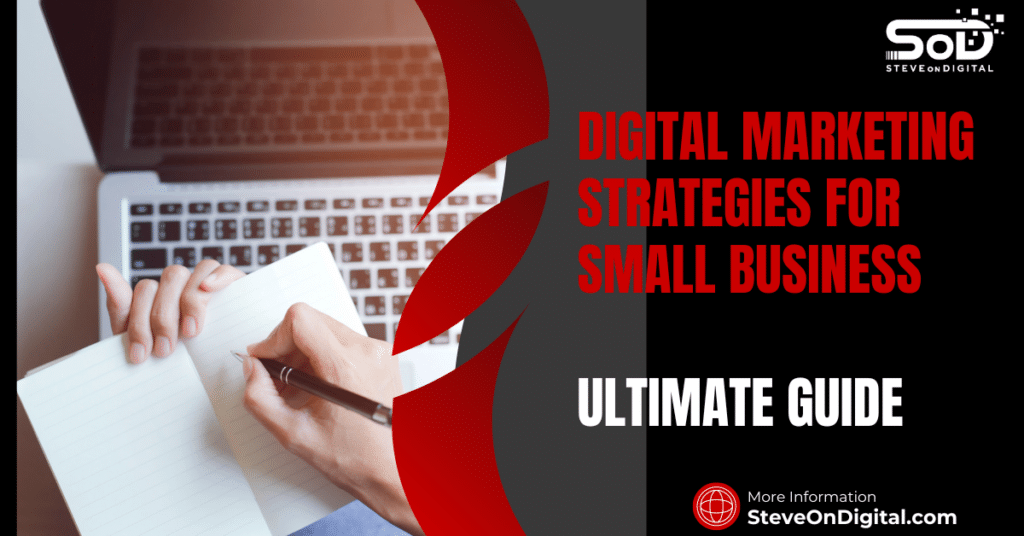
Digital marketing encompasses all marketing efforts that use an electronic device or the internet. Businesses use the internet, like search engines, social media, email, and other websites, to talk to people who might buy their stuff, and to keep in touch with the ones who already do. For small businesses, it’s not just an option; it’s an essential way to reach your audience, execute marketing strategies effectively, and foster growth. Digital marketing has evolved from traditional methods to a complex ecosystem that enhances how businesses engage with their customer base. For me, Steve Johnston, diving into digital marketing was a transformation from traditional marketing methods to embracing technological advancements that empower small businesses to compete on a global scale. Importance Of Digital Marketing For Small Businesses Digital marketing offers small businesses a platform to compete with bigger competitors and reach a wider audience without needing a hefty budget. Benefits include increased visibility, higher website traffic, and improved conversion rates. From my experience, using digital marketing strategies effectively has led to noticeable improvements in sales and customer engagement without the overhead costs associated with traditional marketing. Crafting A Robust Digital Marketing Strategy Setting Foundations: Goals And Target Audience Identifying your target audience is the first step to creating an effective digital marketing strategy. Knowing what people like, how they act, and what bothers them helps you make your marketing fit exactly what they want. As a small business owner, I’ve found that setting SMART goals—Specific, Measurable, Achievable, Relevant, and Time-bound—provides a clear roadmap and measurable targets for our digital marketing efforts. Developing Your Digital Marketing Plan A successful digital marketing plan integrates various strategies to ensure a comprehensive approach to reaching your target audience. This includes using a mix of social media marketing, content marketing, SEO, and email marketing to create a diverse and robust marketing strategy. Leveraging digital marketing tools has been a game changer in how I plan and execute campaigns, providing valuable insights and analytics to refine strategies continually. By understanding the nuances of digital marketing and how to implement effective strategies, small business owners can maximize their potential to attract new customers, engage existing ones, and drive growth. My approach has always been to focus on creating high-quality content and leveraging digital tools to optimize every aspect of our marketing campaigns, ensuring every strategy is well-suited to the dynamics of today’s digital world. Strategy Benefits Tools Often Used SEO Increases organic reach and visibility Google Analytics, SEMrush Content Marketing Engages and retains customers WordPress, Canva Social Media Marketing Builds brand awareness and customer loyalty Hootsuite, Buffer Email Marketing Personalizes customer communications Mailchimp, Constant Contact Core Strategies In Digital Marketing Search Engine Optimization (SEO) SEO is the practice of optimizing your business website to rank higher in search engine results, thus driving more organic traffic to your site. As a small business owner, mastering the basics of SEO has been pivotal in increasing our website traffic and enhancing our online visibility. Key strategies that have proven effective include optimizing our site with relevant keywords and improving site speed and mobile responsiveness. Through diligent application of these tactics, we have seen a marked improvement in our search engine rankings, making it easier for potential customers to find us online. Content Marketing High-quality content is the backbone of any successful digital marketing strategy. It not only helps attract customers but also retains them by providing helpful information and engaging experiences. Over the years, I have focused on creating content that resonates with our target audience, from informative blog posts to interactive videos. This approach has significantly boosted our ability to engage existing customers and attract new ones by delivering valuable content that meets their needs. Social Media Marketing Social media platforms are an essential tool for building a strong online presence and engaging directly with your audience. I have utilized various social media channels to share content, announce new products, and engage in real-time with our community. Creating compelling social media posts and running targeted social media ads have been crucial in enhancing our brand’s online presence and engaging with the community. These efforts have allowed us to foster a strong social media presence, helping drive website traffic and increase sales. Email Marketing Email marketing is a powerful tool for small business marketing, allowing for direct communication with potential and existing customers. It has been instrumental in nurturing leads and converting them into loyal customers by providing them with targeted information and offers. Best practices I’ve adopted include personalizing emails and segmenting our audience to ensure the right messages reach the right people. Through effective email marketing campaigns, we have been able to maintain a direct line of communication with our customers, driving both engagement and sales. Advanced Digital Marketing Techniques Paid Advertising And Google Ads Paid advertising, particularly pay-per-click (PPC) campaigns, is a crucial component of digital marketing strategies for small business. As a small business owner, I’ve leveraged Google Ads to specifically target prospective customers who are searching for services we offer. This direct approach helps in driving targeted website traffic quickly and effectively. Designing effective ads involves understanding the target customer’s needs and crafting messages that resonate with them. Using relevant keywords and a clear call-to-action has significantly increased our click-through rates and driven more conversions. From my personal experience, continuous testing and adjustment of ad copy and targeting options are vital to optimize the performance and ROI of your PPC campaigns. Video Marketing Video marketing has become an indispensable part of a strong online presence. The ability to convey complex information in an engaging and digestible format makes video a powerful tool to attract customers. As someone who has integrated video content into our digital marketing efforts, I’ve seen firsthand the impact of sharing helpful information and personal stories through video. Tips for creating impactful video content include focusing on storytelling, maintaining high-quality production, and ensuring content is informative and directly beneficial to the viewer. Using videos on social media platforms and our business website
How Can SMEs Be Sustainable? | A Complete Guide

Hello there! I’m Steve Johnston, the mind and hands behind SteveOnDigital. Today, we’re diving into a topic close to my heart and crucial for all of us running small and medium-sized enterprises (SMEs): sustainability. Having navigated the digital landscape and seen first-hand the shifts in consumer behavior and regulatory demands, I’ve grown increasingly committed to steering businesses towards sustainable practices. Let’s explore how SMEs like ours can not only thrive but do so responsibly. Addressing environmental and social challenges is fundamental for SMEs, emphasizing the global importance of our role in sustainability and the fight against climate change. Why Sustainability Is Crucial For SMEs In our world today, sustainability is no longer a nice-to-have; it’s a must-have. As an SME owner, I’ve observed a significant uptick in both the challenges and opportunities presented by adopting sustainable practices. Here’s why it’s essential: Let me share a bit of data to back this up. Reports suggest that companies committed to sustainable practices report up to 20% higher profitability compared to those that aren’t. Moreover, 50% of consumers worldwide are willing to pay more for goods and services from companies committed to positive social and environmental impact. Laying The Groundwork For Sustainable Business As the owner of SteveOnDigital, I’ve committed myself and my business to understand and implement sustainable practices, a journey that’s both challenging and rewarding. Here, I’ll break down what sustainability really means for us, small and medium-sized enterprises (SMEs), and how we can lay the groundwork for a greener future. It’s crucial for SMEs to incorporate sustainability into their operations as a step towards a more sustainable and responsible business model. What Is Sustainability In Business? For SMEs, sustainability is about operating in a manner that ensures long-term economic performance, environmental health, and social equity. Here are some key concepts: SMEs As Catalysts For A Sustainable Economy SMEs like ours play a vital role in the global economy, accounting for a significant portion of employment and economic activity. Here’s how we can be catalysts for change: Challenges On The Path To Sustainability Despite our best intentions, the road to sustainability is fraught with challenges: Navigating Global Supply Chain Sustainability Managing a sustainable supply chain is crucial for reducing our environmental footprint. Here are a few strategies I’ve learned and implemented in my business: By understanding these foundational aspects, SMEs can start to make informed decisions that align with both business goals and environmental needs. Strategic Implementation Of Sustainable Practices As we continue our journey into sustainability, it’s crucial to translate our commitment into actionable strategies. Here’s how we, as a medium-sized enterprise, have been embedding sustainable practices into our daily operations and planning for the long term. These steps aren’t just theoretical; they’re practical changes that have truly transformed how we do business. Embracing responsible business practices is essential in demonstrating our commitment to sustainability, attracting environmentally conscious customers, and making a positive impact on society and the planet. Aspect Traditional Practice Sustainable Practice Benefit of Sustainable Practice Energy Use of fossil fuels Adoption of renewable energy Reduces emissions and energy costs Waste Management Disposal in landfills Recycling and composting Minimizes environmental impact Supply Chain Global sourcing Local sourcing Reduces transport emissions, supports local economies Advancing Renewable Energy And Efficiency In our pursuit of sustainability, one of the first steps was to reduce our energy consumption. This isn’t just about being eco-friendly; it’s also about being economically savvy. Here’s how we’ve been making it happen: Achieving Waste Reduction And Promoting Recycling Waste reduction is another critical area where we’ve focused our efforts. Here’s what we’ve done: Community Engagement And Localized Strategies Sustainability is as much about people as it is about the planet. Here’s how we engage with our community: Economic Advantages Of Sustainable Practices Let’s talk numbers, because sustainability isn’t just good for the planet—it’s great for business too. Here’s what we’ve observed: Monitoring And Evaluating Sustainability Impact As we dive deeper into making SteveOnDigital a paragon of sustainability, it’s crucial not just to implement sustainable practices but also to monitor and evaluate their impact. Here’s how we can effectively measure and keep tabs on our sustainability performance. Incorporating sustainable initiatives is essential for tracking and reinforcing sustainability efforts within businesses, highlighting the importance of a dedicated approach to ecological transition and the benefits it brings to both the environment and the economy. Using Sustainability Metrics And Standards To truly gauge the effectiveness of our sustainability efforts, we rely on specific metrics and standards that give us a clear picture of our impact. Here’s how we approach this: Metric Description Carbon Footprint Total amount of greenhouse gases produced, measured in CO2 equivalents. Energy Efficiency Energy usage relative to output, aiming for lower ratios. Waste Reduction Percentage reduction in waste produced compared to a baseline year. Water Usage Total water consumption, with goals to reduce usage over time. The Importance Of Sustainability Certifications Sustainability certifications are more than just badges for a business; they’re a testament to our commitment and compliance with global standards. Here’s why they’re essential: Leveraging Support From Financial Institutions Sustainability isn’t just a cost center; it’s also an area where we can gain financial advantages through support from eco-minded financial institutions. Here’s how we benefit: Incentive Type Description Potential Benefit Green Bonds Bonds specifically intended for climate or environmental projects. Access to cheaper capital for sustainability projects. Government Grants Funds provided by government bodies for eco-friendly upgrades. Non-repayable funding to support transition to green operations. Tax Breaks Reductions or exemptions in taxes for sustainable practices. Lower operational costs and encouragement for green investments. By keeping a close eye on these metrics and leveraging the support systems available, we not only stay true to our sustainability goals but also ensure that our business remains viable and competitive in a rapidly evolving market. This approach not only supports SteveOnDigital in its green mission but also serves as a blueprint for other SMEs striving to make a difference. Gaining A Competitive Edge Through Sustainability We’ve seen firsthand how
How To Develop A Small Business Sustainability Plan | Last Guide
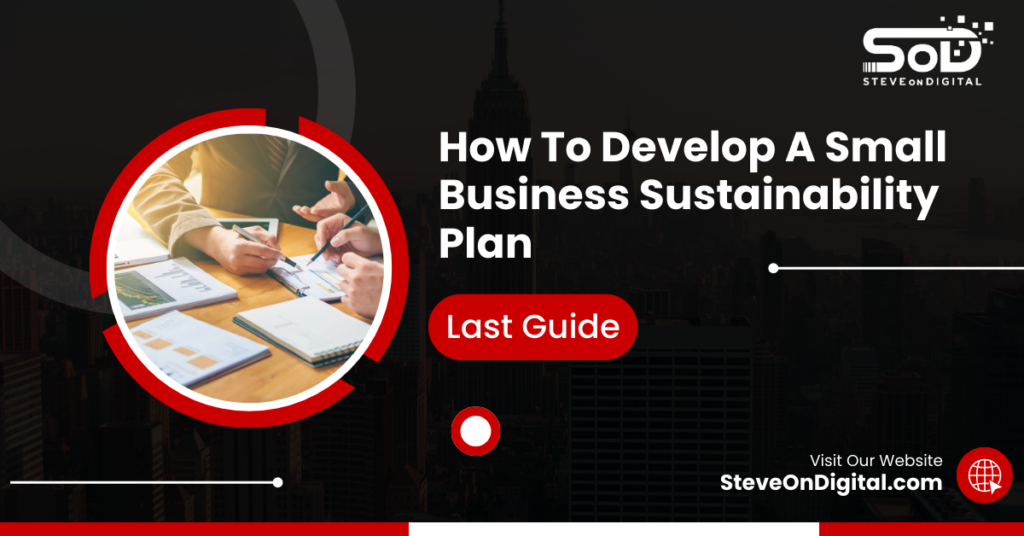
As a small business owner and the mind behind SteveOnDigital, I recognize the urgency and necessity of integrating sustainability into our business practices. In today’s rapidly changing environment, developing a sustainability plan is not just about being responsible; it’s about ensuring the future of our business and the world we live in. Why Embrace Sustainability? The Compelling Case For Small Businesses Embracing environmental sustainability within your small business isn’t just beneficial for the planet—it’s a strategic business move. Research shows that sustainability is increasingly influencing consumer choices. A significant 50% of consumers now consider sustainability one of their top four purchasing criteria (TravelPerk). Moreover, businesses that invest in sustainable practices report financial benefits too. A McKinsey study found that companies incorporating environmental, social, and governance (ESG) factors into their growth strategies were twice as likely to see a revenue increase of 10% or more (TravelPerk). Economic Benefits Of Sustainability Sustainability can lead to substantial cost savings, primarily through improved energy efficiency and reduced waste. Businesses worldwide could save a significant amount annually by 2030 through energy efficiency alone (TravelPerk). On my journey with SteveOnDigital, I’ve seen firsthand how small changes, like upgrading to LED lighting or optimizing our digital tools, not only reduce costs but also enhance operational efficiency. Boosting Customer Loyalty And Brand Image Today’s consumers are more eco-conscious than ever. They’re willing to pay more for products from sustainable companies, and they value transparency about sustainable practices. By aligning your business with these values, you not only attract a loyal customer base but also enhance your brand’s reputation (TravelPerk) (QuickBooks). Competitive Advantage Adopting sustainable practices can distinguish your small business from competitors. As we integrate eco-friendly solutions at SteveOnDigital, I’ve noticed how it piques the interest of potential clients and partners who are eager to support green businesses. This not only opens new markets but also strengthens our standing in the industry. Integrating sustainability isn’t just about adopting new practices—it’s about setting a foundation for future growth and stability. Whether it’s through reducing energy consumption, optimizing supply chains, or ensuring that all business activities are geared towards minimizing environmental impact, the goal is clear: a sustainable business is a thriving business. By focusing on these key areas, we position our small businesses not just to survive but to thrive in a future where sustainability is expected, not just appreciated. Building The Foundation: Key Components Of A Small Business Sustainability Plan Over the years, I’ve learned that laying a strong foundation is crucial for any successful initiative—especially when it comes to sustainability in small businesses. A well-thought-out sustainability plan not only addresses immediate environmental concerns but also sets up a business for long-term success. It’s important to create a sustainable business plan that incorporates creativity, innovation, and self-reflection to identify new ways to reduce waste and energy consumption. Defining Your Sustainability Vision Every impactful journey begins with a clear vision. For small businesses aiming to integrate sustainability, this vision should encapsulate not just what you aim to achieve but also why it matters. This vision might be about reducing energy consumption, minimizing waste, or enhancing your community’s well-being—goals that reflect both your values and business objectives. For instance, at SteveOnDigital, our vision for sustainability involves reducing our carbon footprint while enhancing digital efficiency for our clients. Conducting A Thorough Sustainability Assessment To know where you’re going, you must first understand where you stand. A sustainability assessment involves a detailed evaluation of your current practices and their environmental impact. This might include examining your energy usage, waste management practices, and supply chain operations. Tools like carbon calculators and energy audits can be invaluable here, providing insights into areas where your business can improve. Data shows that many businesses are now adopting more sustainable practices, with significant emphasis on energy efficiency (TravelPerk). Setting Achievable Sustainability Goals Once you’ve assessed your current state, the next step is to set concrete, achievable sustainability goals. These should be SMART: Specific, Measurable, Achievable, Relevant, and Time-bound. For example, you might aim to reduce your office’s energy consumption by 20% within the next two years or achieve zero waste to landfill by 2025. These goals not only guide your sustainability efforts but also help motivate your team by providing clear targets to strive for. Implementing Effective Sustainability Initiatives With your sustainability goals set, it’s crucial for small businesses to start implementing sustainable business practices. This could mean investing in energy-efficient appliances, switching to renewable energy sources like solar panels, improving your recycling processes, or using renewable materials and facilitating virtual meetings to reduce carbon footprint. The key is to choose initiatives that align with both your sustainability goals and business needs. For instance, upgrading to LED lighting not only reduces energy consumption but also cuts down on maintenance costs, offering quick returns on investment (TravelPerk) (QuickBooks). Overcoming Common Challenges Adopting new practices isn’t without its challenges. Small businesses often face hurdles such as limited budgets, lack of expertise, or resistance to change. Overcoming these challenges requires creativity and persistence. Financial incentives, such as grants or tax breaks, can ease budget constraints. Training and engaging employees can help foster a culture that embraces sustainable practices. Sustainability In Action: Case Studies And Success Stories To illustrate what’s possible, let’s look at some real-life examples of small businesses that have successfully implemented sustainability plans. These stories not only serve as inspiration but also as proof that small businesses can make a significant impact. For instance, a local café might reduce waste by implementing comprehensive recycling and composting programs, while a small manufacturing firm might decrease its environmental impact by adopting more efficient production techniques. These elements form the core of a robust small business sustainability plan. By defining a clear vision, conducting thorough assessments, setting specific goals, implementing effective initiatives, and overcoming challenges, your business can not only contribute positively to the environment but also enhance its operational efficiency and brand reputation. Deep Dive Into Sustainability Practices I’ve learned that sustainability isn’t just a trend; it’s a vital
AI – Impact On Small Businesses | Complete Guide
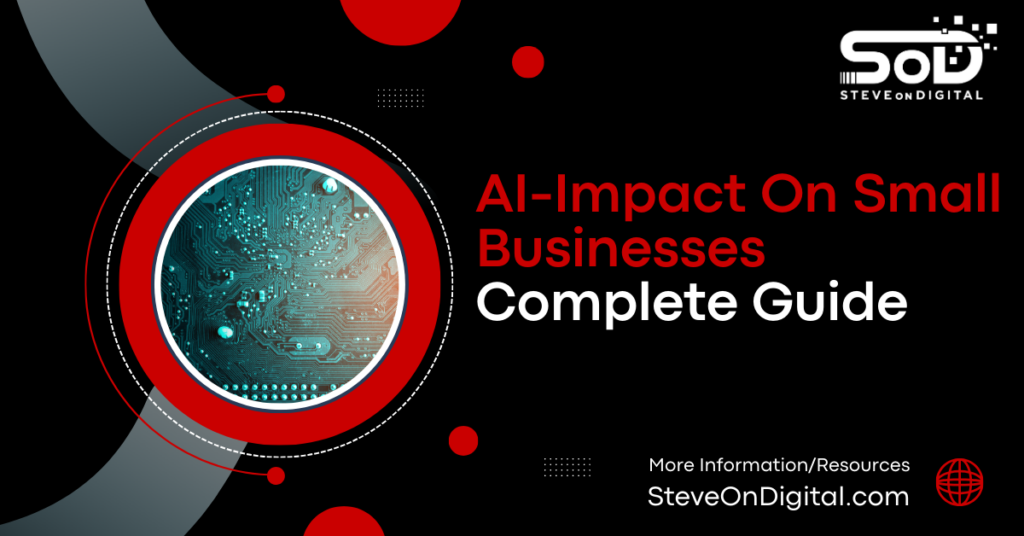
Hello, I’m Steve Johnston, the owner and author of SteveOnDigital, and today I want to explore the profound impact of AI on small businesses. As someone deeply entrenched in the digital transformation landscape, particularly for small and medium-sized enterprises (SMEs), I’ve witnessed firsthand how AI is reshaping the way we do business. Impact Of AI On Small Businesses Artificial Intelligence (AI) means machines that act smart like humans to do things and can get better by learning from what they see. AI encompasses a range of tools including machine learning, where computers can be trained to recognize patterns and make decisions based on data. The role of AI in modern business is expansive, influencing everything from data analysis to customer interactions and inventory management, with a variety of AI tools, including AI plug-ins and systems like ChatGPT, offering a spectrum of applications beneficial for small businesses. Overview Of AI Tools And Technologies For small businesses, AI technologies provide a competitive edge by offering valuable insights and automating repetitive tasks. Common AI tools that are particularly beneficial include virtual assistants for handling customer inquiries, chatbots for enhancing the customer experience, and analytical tools that help in recognizing patterns in vast amounts of data quickly. AI Tool Benefits for Small Businesses Virtual Assistants Handles customer inquiries efficiently, reducing wait times. Chatbots Enhances customer service by providing instant responses 24/7. Analytical Tools Quickly identifies patterns in large data sets for better decision-making. AI Plug-ins Integrates with existing software to improve functionality and automation. These tools are not just about technology—they represent a pivot towards more strategic, efficient operational models. The Growing Importance Of AI The adoption of AI by most small businesses has shown notable increases in efficiency and improvements in customer service. AI systems help businesses manage their resources more effectively, ensuring they can focus on growth and innovation. For instance, AI can analyze customer behavior patterns to provide personalized experiences, a crucial factor in building loyalty and satisfaction in today’s market. Implementing AI For Business Operations And Strategic Growth As we delve deeper into the applications of AI, it’s evident that small business owners can leverage this technology to dramatically enhance their operations and position themselves for significant growth. Efficiency And Productivity Enhancement Automation Of Repetitive Tasks Using AI Systems ‘One of the most immediate benefits of AI for small businesses is the automation of mundane, repetitive tasks. AI software can handle activities like scheduling, data entry, and even certain aspects of customer service, freeing up human employees to focus on more complex and creatively demanding tasks. This shift not only improves operational efficiency but also employee satisfaction. AI Application Task Automated Impact on Business Efficiency Automated Scheduling Systems Scheduling and data entry Reduces manual labor and error rates, increasing operational speed. AI Customer Service Platforms Handling routine inquiries Frees up staff for complex tasks, enhancing service quality. AI Financial Tools Generating financial reports Automates analysis, speeding up decision-making processes. AI In Inventory Management AI tools are particularly effective in inventory management, a critical area for many small businesses. AI systems can predict stock needs based on trend analysis, helping businesses maintain optimal stock levels and streamline order processing. This kind of efficiency in operations directly contributes to smoother business processes and reduced overhead costs. Implementing AI For Faster And More Accurate Data Analysis In the realm of data analysis, AI proves invaluable. AI technologies can process vast amounts of data from various sources to derive actionable insights swiftly. This capability allows small business owners to make informed decisions quickly, a decisive advantage in today’s fast-paced market environments. The Strategic Adoption Of AI Technology In the swiftly transforming landscape of modern commerce, artificial intelligence (AI) serves as a cornerstone for enabling small businesses to excel and adapt. By integrating AI tools such as machine learning algorithms and virtual assistants, these enterprises can greatly enhance customer interactions and inventory management, leading to remarkable improvements in operational efficiency. Such technologies are instrumental in allowing small business owners to analyze vast amounts of data quickly, offering valuable insights that drive business growth. AI systems also facilitate enhanced employee training, ensuring that workforce skills align with evolving technological demands. This strategic adoption of AI technology not only secures a competitive edge but also catalyzes sustained economic contributions by small businesses. Business Operation AI Application Expected Outcome Inventory Management Predictive stock needs analysis Optimized stock levels, reduced costs Customer Service Personalized customer interaction Increased customer loyalty and satisfaction Data Analysis Fast processing of large data sets Quick and informed decision-making Marketing Targeted campaigns and content creation Enhanced customer engagement and higher conversion rates Enhancing Customer Interactions And Experience Role Of AI In Managing Customer Inquiries Through Virtual Assistants AI-driven virtual assistants are revolutionizing the way small businesses handle customer inquiries. These AI tools efficiently manage large volumes of inquiries without human intervention, ensuring that customers receive timely and accurate responses. AI Feature Functionality Customer Benefit Personalized Marketing Analyzing customer data for preferences Tailors marketing messages, enhancing user engagement. Proactive Service Bots Predicting customer needs Addresses needs proactively, increasing satisfaction. Real-time Response Systems Handling inquiries instantaneously Improves response times dramatically, ensuring customer needs are met swiftly. My experience with AI in customer service highlights its ability to maintain high standards of customer interaction without significant resource expenditure. Personalizing The Customer Experience With AI-Driven Insights Further, AI’s ability to analyze customer interactions and feedback provides small businesses with the insights needed to tailor services and products to individual preferences. This personalization is crucial for enhancing the customer experience and building stronger relationships with clients. Utilizing AI Tools For Improved Customer Service And Engagement Lastly, AI technology fosters enhanced customer service by predicting customer needs and offering proactive solutions. For instance, AI can suggest additional purchases or remind customers about upcoming events, which enhances engagement and fosters a deeper connection between the business and its customers. AI’s Transformational Impact On Marketing And Sales As a digital transformation specialist, I have utilized AI extensively to refine marketing strategies and
What Is Data Analytics And How It Can Improve Your Business? | SOD
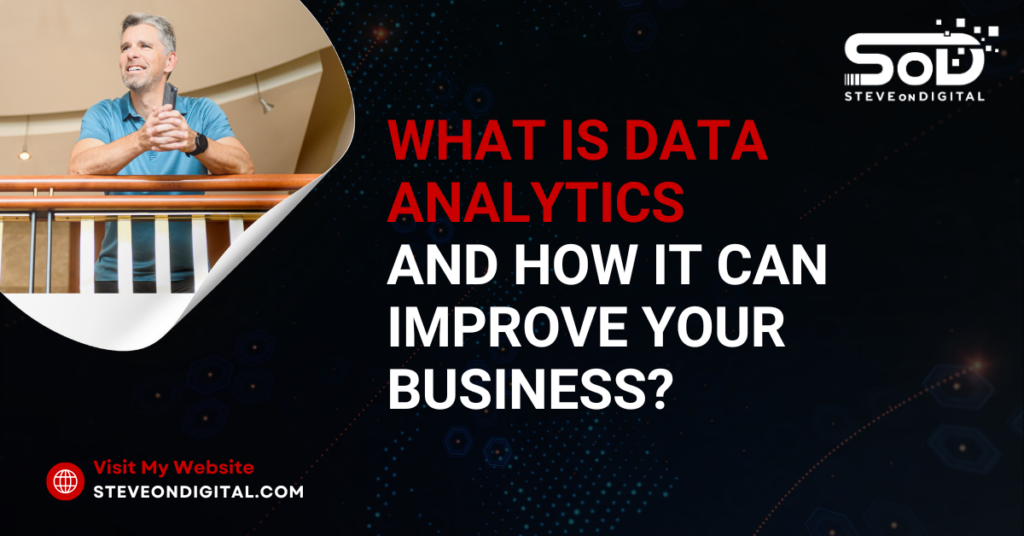
In today’s fast-paced and technology-driven world, data analytics stands as a cornerstone of modern business. As Steve Johnston, owner and author of SteveOnDigital, I’ve witnessed firsthand the transformative power of data analytics across various sectors. Data analytics involves examining raw data to glean insights that inform business decisions, enhancing efficiency and profitability. Business intelligence plays a critical role in this landscape, providing the necessary tools and frameworks to understand vast amounts of data effectively. Core Concepts: Data Analytics, Business Intelligence, And Customer Data Data analytics is not just a buzzword but a fundamental component of strategic decision making in many businesses today, including small and medium-sized enterprises (SMEs). By integrating data analytics, business intelligence, and insights derived from customer data, companies can unlock new opportunities and gain a competitive edge. From optimizing supply chains to tailoring marketing strategies, the impact of data analytics is profound and far-reaching. Understanding The Data Analytics Process From Data Collection To Data Analysis The data analytics process starts with collecting raw data, which can range from sales figures and customer interactions to market trends and beyond. This raw data is often voluminous and unstructured, making it challenging to process. However, with the right tools and techniques, such as data science and machine learning, this data is transformed into structured, analyzable sets. Once structured, the process of analyzing data begins, using statistical tools and algorithms to identify patterns, trends, and relationships. Exploring Data Types In my experience, understanding the difference between unstructured data and structured data is crucial. Unstructured data, such as emails, videos, and social media posts, is formless and not easily sorted through traditional data models. On the other hand, structured data is organized and easily searchable, often stored in relational databases. Effective data analytics requires tools that can handle both types, integrating them into a coherent analysis that supports business intelligence. Role Of Data Analysis In Business Strategy Leveraging Historical And Sales Data For Strategic Planning Analyzing historical data and sales data allows business leaders to not only assess past performance but also to forecast future trends and prepare accordingly. For instance, by examining historical sales data, businesses can predict customer demand, optimize stock levels, and even adjust pricing strategies to maximize profits. This predictive analytics approach is something I often discuss on my platforms like YouTube and LinkedIn, illustrating its importance with real-life examples from SMEs. Real-World Success One compelling case study involves a retail client who leveraged data analytics to revamp their inventory management system. By analyzing customer data and sales data, they could better predict which products would be in high demand. This not only reduced overstock and understock situations but also enhanced customer satisfaction as popular items were always in stock. Another example is a service provider who used customer feedback and data analysis to refine their service offerings, significantly increasing customer retention and satisfaction. In both examples, the businesses utilized data analytics to not only understand their current market position but also to anticipate market trends and adapt their strategies accordingly. As someone deeply embedded in the digital transformation space, I’ve advised numerous companies on similar strategies, ensuring they harness the full potential of their data to drive business success. How Data Analytics Enhances Customer Understanding Analyzing Customer Behaviors And Trends Understanding customer behavior is pivotal in today’s business environment. As the head of SteveOnDigital, I have consistently leveraged data analytics to delve deep into customer trends and behaviors. This approach is essential because it allows businesses to understand what motivates customer actions, preferences, and buying patterns. By analyzing customer data and observing how these trends evolve, businesses can tailor their products and marketing strategies to meet the precise needs of their consumer base, leading to increased customer satisfaction and loyalty. Enhancing Customer Experiences Through Data Insights One effective technique for analyzing customer interactions involves the use of sophisticated data analytics tools that track and record every touchpoint a customer has with your business. This might include website visits, social media interactions, and direct communications. By employing data science and machine learning algorithms, we can extract actionable insights from this data, helping to refine customer service approaches, personalize communication, and ultimately enhance the overall customer experience. For instance, through my digital platform, we’ve implemented chatbots that analyze incoming customer queries to provide instant, relevant responses that are tailored to individual needs, significantly improving user satisfaction. Predictive Analytics And Identifying Market Trends Forecasting The Future With Predictive Analytics Predictive analytics is a form of advanced analytics that uses historical data along with machine learning and statistical algorithms to predict future outcomes. In my role at SteveOnDigital, I’ve used predictive analytics to anticipate customer demand and spot emerging market trends before they become apparent. This capability is crucial for adjusting business strategies dynamically and ensuring competitive advantage. For example, by analyzing historical sales data and customer behavior patterns, we can forecast which products will see increased demand, allowing for better stock management and marketing focus. Staying Ahead Of Market Changes Through Predictive Models The main benefit of predictive modeling is its ability to provide business leaders with foresight, rather than just insight. This forward-looking approach not only helps in anticipating changes in the market but also in preparing more robustly for potential disruptions. Predictive models can identify trends that inform product development, marketing strategies, and even risk management practices, helping businesses stay one step ahead of competitors and align more closely with customer expectations and needs. Metric Before Predictive Analytics After Predictive Analytics Improvement Forecast Accuracy 70% 90% 20% increase Customer Demand Prediction 65% 88% 23% increase Market Trend Identification 60% 85% 25% increase Using Data To Streamline Operations And Reduce Costs Optimizing Business Operations With Data Analytics Data analytics is instrumental in streamlining operations within a company. By analyzing data from various business operations, companies can identify inefficiencies and areas for improvement. For example, in my experience, by analyzing workflow and production data, we have been able to optimize processes to reduce waste and increase throughput. Moreover, data

